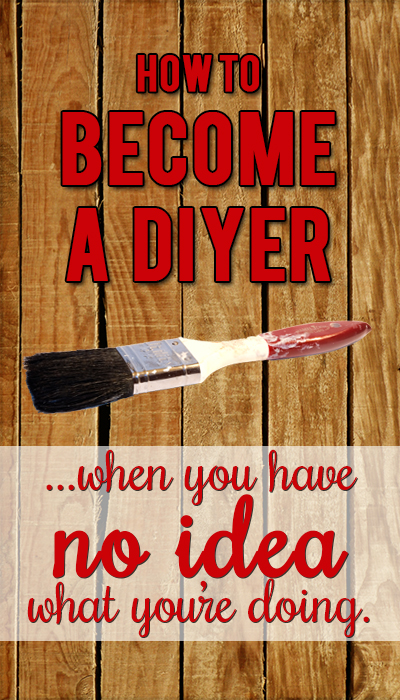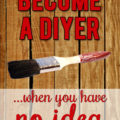The Do It Yourself epidemic has taken over a vast proportion of the American households. But not everyone feels conquered about it. For some, DIY is worst than an urban insult. It is a living nightmare. The simple idea of crafting something seems overwhelming for non-DIY people who find it hard to imagine that there could be any joy in such activities. More importantly, they find it hard not to feel resentful towards anybody who enjoys sitting down and building new stuff: They make it look so easy, and you are left with only frustration when you try to replicate their success. There is no logical reason why you should think that DIY is just good for others. Don’t say it’s not your thing; we bet that we can change your mind. After all, while DIY fear is natural, it doesn’t mean that you should let it rule over your life. Being in a position to proceed with home improvement and renovation projects by yourself and to know exactly what you need to do to fix the light or the plumbing is a position of power indeed. And it’s a position that you could enjoy too if you follow the advice in this article. After all, don’t you want to be able to reveal the full potential of your home? So it’s time to find your DIY mojo for good!
The Fear Of DIY
It seems impossible to believe that DIY – which used to be a way of saving costs at home by making your own clothes, fixing the table, building a bed, or baking your own bread – is now threatening to become a lifestyle for a vast part of the global population. Some DIY chains even offer the possibility to create your own wedding list, as if there were nothing else that you’d want more to celebrate the beginning of your union than a pair of anti-rust screwdrivers and a hot glue gun. Some people, as mysteriously insane as it might sound, seem very excited about the prospect. Others, and maybe you are one of these, are seriously wondering what has gone wrong with the rest of world. Are we all now at risk of becoming a nation of babbling gluers, crocheters and hammerers with no other prospect than the joy of owning our very own custom made shed at the back of the garden? Don’t panic; this isn’t an option. Besides, there is more to DIY than just that. But if you look at those who can tell a hammer from a screwdriver with frustration – if not irritation –, if you can’t look at a breach in the wall plaster without breaking in a cold sweat, then you have DIY fear. DIY fear is not deadly per se; it’s not really handicapping either. But it significantly limits the positive memories you create in your home. When each little and insignificant DIY problem becomes an insurmountable mountain, it’s likely that your household is both stressful and expensive to run.
You Were Not Born With It
For a start, it is essential to get the truth out there. DIY is a set of skills. It’s far from being natural to anybody. Don’t believe what your craft-addict best friend says: Even she wasn’t born with a hammer at the end of the arm. However, there is no denying that some individuals will find it easier than others. More often than not, your interests, your sense of curiosity and your upbringing will make you feel connected to new skills, even if you have never done anything similar before. For example, if you grew up in a family where you’ve observed your parents work with DIY tools to produce new things or to fix broken items, it’s likely that you will naturally associate positive memories with the DIY activity. You will approach your first DIY project with an optimistic mind. Besides, you will have also benefitted from a form of passive learning through observation. But if you’ve never seen your parents with a hammer in hand, it is very probably that you might feel a little anxious about taking the first step. Additionally, without any role model to refer to, it’s difficult to know what you should be doing instinctively. Thankfully, you are not on your own here. There are plenty of online DIY tutorials to help you go through a variety of home improvement and renovation projects. Also, there is something that you shouldn’t forget. Everyone needs to start somewhere. Just because you start now and today doesn’t mean that you can’t master DIY at home!
Get The Tools For The Job
When you start watching DIY tutorial videos and reading about the topics – while you might think that it is teaching yourself a new skill… Well, you are perfectly right: It is only about teaching yourself a new skill; that’s what DIY is – you begin to realize one important thing. DIY needs special equipment. You can still hammer a nail through the wall with the back of your shoe, but you’ll do a better job with a hammer, and preferably in the appropriate dimension and weight. Yes, when you embrace a DIY project, you need to give your toolbox some serious love. And that means DIY shopping for tools. In truth, you will need a lot less than you think. But let’s be honest, it’s the equivalent of taking on cooking if you have never set foot in the kitchen before. You will need to buy everything from cutlery to frying pans via oven. It can be a lot in one go, but you can simply gradually build a tool box, by buying only the tools you need for each DIY job you start. For instance, if you are mounted a set of shelves on the wall, then an electric drill will do wonder – Bosch is a brand that you can trust for quality, whether for cordless or with a cord tools. Now, if you are working on your electrical system, let’s say that you are trying to figure out whether a socket is broken or not, a multimeter is what you need – the fluke 116 multimeter is one of the best multimeters available at Tool Nerds if you are looking for a piece of advice. So, while you will need to get your hand on all basic tools – you can hire specialist tools – it can be a gradual process of acquisition. Don’t break the bank to get the perfect toolbox now. You don’t need it.
Plan And Research First
As a general rule, when you approach a DIY task, even if it is something as simple as putting a new carpet in the hall, you need to plan everything very thoroughly. Indeed, lack of planning can lead you to increased costs and a lot of frustrated feelings. To go back to the carpet example, measuring how much carpet you need starts with a diagram of your house. You will use this to register the measurements of each room, which means the length and the width of the room in this case. Only then can you estimate the total cost of the project. To take another example, most homeowners spend between $5,500 and $13,200 to remodel their bathroom. However, some will spend up to $21,000. Most commonly, these high costs are driven by poor planning and budgeting. So do your research and make sure that you know what you are doing.
Start With Simple Projects
There is no reason to be worried about DIY. You can start with a simple project to trial your hand at the skills you’ve learned. Redecorating your bedroom is, for example, a great way to test the DIY water. You can limit your involvement to simple tasks, such as changing the curtains, upgrading the bed – bonus point if you need to assemble the new bed – and eventually giving your walls a fresh coat of paint. As you start to feel more confident, you can move to more complex projects.
Then Make The Home Your Playground
Feeling confident? It’s time to start transforming your home into a customized paradise. For example, you can find a use for the space underneath the stairs: Why not turn it into a library? Or a quirky storage room? If you are a pet lover, you could convert an unused space into a dog’s room for your furry friend. The possibilities are endless once you follow the DIY magic. If you are up for a wonderful challenge, you could build a treehouse in your garden. You know the kids will love it … and you will too!
Feel Good About Yourself
Last, but not least, there is something positive about DIY: It makes you feel good about yourself. DIY puts you in control and helps you to release your creativity. The act of creation, and especially when it involves mastering external elements such as a plank of wood or your plumbing system, has a powerful impact on your well-being. Feeling happy, escaping stress, and finding creative solutions to remodel your home at low costs, all these are the advantages that come from defeating your DIY fear.
Related Posts
- New Year Fitness Resolutions And Tips to Help You Stick To Them
I just got back from a long vacation in India a few days back, and…
- Tips For Starting A Home Business From Scratch
Starting a home business from scratch isn’t easy, and it’s important that whatever you end…
- DIY: Make a Sunburst Wall Mirror in Less Than 15 mins
If you are like me, you've always looked at those $100 Sunburst Mirrors at Pier…




















